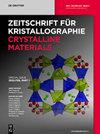Occupancy disorder in the magnetic topological insulator candidate Mn1−x Sb2+x Te4
IF 2.7
4区 材料科学
Q3 CRYSTALLOGRAPHY
Zeitschrift Fur Kristallographie-Crystalline Materials
Pub Date : 2021-12-28
DOI:10.1515/zkri-2021-2057
引用次数: 4
Abstract
Abstract MnSb2Te4 is a candidate magnetic topological insulator exhibiting more pronounced cation intermixing than its predecessor MnBi2Te4. Investigating the cation intermixing and its possible implications on the magnetic order in MnSb2Te4 are currently hot topics in research on quantum materials for spintronics and energy-saving applications. Two single-crystal X-ray diffraction measurements of Mn1−x Sb2+x Te4 (x = 0.06 and x = −0.1) are presented alongside a detailed discussion of its crystal structure with a spotlight on the apparent occupancy disorder between the two cations. This disorder has been noted by other groups as well, yet never been analyzed in-depth with single-crystal X-ray diffraction. The latter is the tool of choice to receive a meaningful quantification of antisite disorder. Between the two synthesis procedures we find subtle differences in phases and/or alternation of the cation content which has implications on the magnetic order, as illustrated by bulk magnetometry. Understanding and assessing this disorder in magnetic topological insulators of the MnX2Te4 (X = Bi, Sb) type is crucial to gauge their applicability for modern spintronics. Furthermore, it opens new ways to tune the “chemical composition – physical property” relationship in these compounds, creating an alluring aspect also for fundamental science.磁性拓扑绝缘体候选材料Mn1−x Sb2+x Te4的占位紊乱
摘要:MnSb2Te4是一种候选磁性拓扑绝缘体,比其前身MnBi2Te4具有更明显的阳离子混合。研究MnSb2Te4中阳离子的混合及其对磁序的影响是目前自旋电子学和节能量子材料研究的热点。本文介绍了Mn1 - x Sb2+x Te4 (x = 0.06和x = - 0.1)的两个单晶x射线衍射测量结果,并对其晶体结构进行了详细的讨论,重点讨论了两个阳离子之间明显的占位紊乱。其他研究小组也注意到这种紊乱,但从未用单晶x射线衍射深入分析过。后者是接受有意义的反位障碍量化的首选工具。在两种合成方法之间,我们发现相和/或阳离子含量的变化有细微的差异,这对磁顺序有影响,如体磁强计所示。理解和评估MnX2Te4 (X = Bi, Sb)型磁性拓扑绝缘体中的这种无序性对于衡量其在现代自旋电子学中的适用性至关重要。此外,它开辟了调整这些化合物的“化学成分-物理性质”关系的新途径,也为基础科学创造了一个诱人的方面。
本文章由计算机程序翻译,如有差异,请以英文原文为准。
求助全文
约1分钟内获得全文
求助全文
来源期刊

Zeitschrift Fur Kristallographie-Crystalline Materials
CRYSTALLOGRAPHY-
CiteScore
2.00
自引率
16.70%
发文量
55
期刊介绍:
Zeitschrift für Kristallographie – Crystalline Materials was founded in 1877 by Paul von Groth and is today one of the world’s oldest scientific journals. It offers a place for researchers to present results of their theoretical experimental crystallographic studies. The journal presents significant results on structures and on properties of organic/inorganic substances with crystalline character, periodically ordered, modulated or quasicrystalline on static and dynamic phenomena applying the various methods of diffraction, spectroscopy and microscopy.
 求助内容:
求助内容: 应助结果提醒方式:
应助结果提醒方式:


